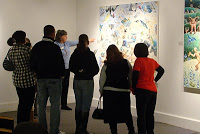
This week’s guest post is from Julia Brucker, Museum Education Coordinator at the Danforth Museum of Art in Framingham, Mass.
On a chilly spring evening, the lights were still burning at the Danforth Museum of Art in Framingham, Mass. People began to arrive in small groups, smiling shyly at the museum guides waiting to greet them, and sometimes turning to talk to a friend in Portuguese or Russian. An hour later, the energy level was transformed. The groups chatted in English, to their museum guides or to each other. The museum buzzed with life and excitement.
 The CFM’s recent blog post, “Empowering New Immigrants through Art ,” inspired me to write about the Danforth Museum of Art’s Language of Art Program. This program, which is supported by the Framingham Cultural Council, is designed for ESL classes to practice new vocabulary and conversational English in response to the artwork on display.
The CFM’s recent blog post, “Empowering New Immigrants through Art ,” inspired me to write about the Danforth Museum of Art’s Language of Art Program. This program, which is supported by the Framingham Cultural Council, is designed for ESL classes to practice new vocabulary and conversational English in response to the artwork on display.
The Museum has a long-standing partnership with an ESL program in Framingham, Massachusetts, called Framingham Adult ESL Plus. Begun in 2002 with a few tentative ESL teachers and the support of their administration, the program has grown to include more than half of the FAESL classes (approx. 300 students), who visit the Museum during the spring semester, using the exhibits to learn new vocabulary and discuss form, color and meaning.
To engage students in conversation, museum guides lead discussions using Visual Thinking Strategies and other open-ended questions. Paraphrasing each student’s response is key. The guide is able to check that all students have understood and model correct grammar and phrasing. At the same time, the act of paraphrasing slows down the conversation, allowing ESL students to better absorb what is said.
Teachers find that the open-ended nature of this tour style even persuades less confident speakers to join the conversation. Sharon, a FAESL teacher, told her docent, “Some of my students who are shy and quiet in class became really engaged in the museum, talking about the art, the pictures. They really opened up. That’s why I take my students here.”
Tour technique and image selection provide the framework for a successful tour, but I consider a tour successful only if the docents and students interact in a meaningful way.
I have noticed that on successful tours, docents interact with ESL students as individuals, listening carefully to each response and demonstrating genuine curiosity about the many different cultures represented in each class. The students, for their part, respond to this attention with astounding energy and engagement, especially considering that they often arrive at the museum after a full day of work. The mutual respect results in a truly rewarding experience for both parties.
As the Nassau County Museum of Art noted in their recent guest post on this blog, students make an emotional connection with art that represents multicultural identities. The Danforth Museum of Art recently exhibited intricate 3D collages by children’s book illustrator, Giles Laroche, depicting buildings from all over the world. Supported by the National Endowment for the Arts, the exhibit was brought to the museum specifically to include multicultural audiences. The response it inspired was recorded by a Danforth docent in his blog:
“After about 15 minutes, Lynn directed us all towards the Bridges Across Cultures gallery on the 2nd floor and what was fun to observe was the emotional response of the students as they got off the elevator and walked in the gallery. Their instant reactions were-“Holaaaa-Waaaoow!”, “Ahaaa”, “Look at the people”, “Look at the temple!”, “Heyyy we have this in our country!” – in short everyone’s face was lit up in this gallery.”
Other exhibits have inspired curiosity and easy conversation, but this particular exhibit was successful on a deeper level.
Do our ESL visitors now feel more comfortable visiting other museums or public buildings where no one speaks their language? Will they return to the Danforth? As classes leave the Museum, ESL teachers are handed forms to evaluate their visit. Many students return with other levels of ESL classes, and they are given passes to return with their families. The Museum’s next steps are to encourage and track future engagement with the Museum and to better function as a relevant public place for new immigrants outside of class.
In her last paragraph, Julia asks the $20 million dollar question—are programs such as the Danforth’s Language of Art “sticky experiences” that lead new immigrants to return and help them feel the museum is “their place?” If your museum has done research on the results of your efforts to foster museum-going in non-traditional audiences, please (please, please) write me at futureofmuseum@aam-us.org and share!









This kind of program sounds like a great way to get new audiences interested in the museum. Even better, it seems like the kind of program that could be replicated in larger cities. When you know more about the long-term impact of this program I would love to hear more!